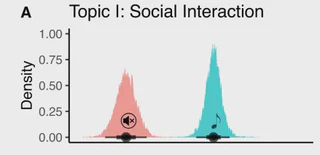Solitary silence and social sounds: music can influence mental imagery, inducing thoughts of social interactions

Abstract
The COVID-19 pandemic was accompanied by a marked increase in the use of music listening for self-regulation. During these challenging times, listeners reported they used music ‘to keep them company’; indicating that they may have turned to music for social solace. However, whether this is simply a figure of speech or an empirically observable effect on social thought that extends into mental imagery was previously unclear, despite its great potential for applications. Here, six hundred participants were presented with silence or task-irrelevant folk music in Italian, Spanish, or Swedish while performing a directed mental-imagery task in which they imagined a journey towards a topographical landmark. To control and differentiate possible effects of vocals and semantics on imagined content, the music was presented with or without vocals to the participants, of which half were native speakers and the other half non-speakers of the respective languages. As in previous studies, music, compared to silence, led to more vivid imagination and shaped emotional sentiment of the imagined content. In addition, we show that social interactions emerged as a clear thematic cluster in participants’ descriptions of their imagined content through Latent Dirichlet Allocation. Moreover, Bayesian Mixed effects models revealed that music increased imagined social content compared to silent baseline conditions. This effect remained robust irrespective of vocals or language comprehension. Using stable diffusion, we generated visualisations of participants’ imagined content. In a second experiment, a new group of participants’ ability to differentiate between visualisations of content imagined during silence and music listening increased when they listened to the associated music. Results converge to show that music, indeed, can be good company.
Type
Publication
Scientific Reports